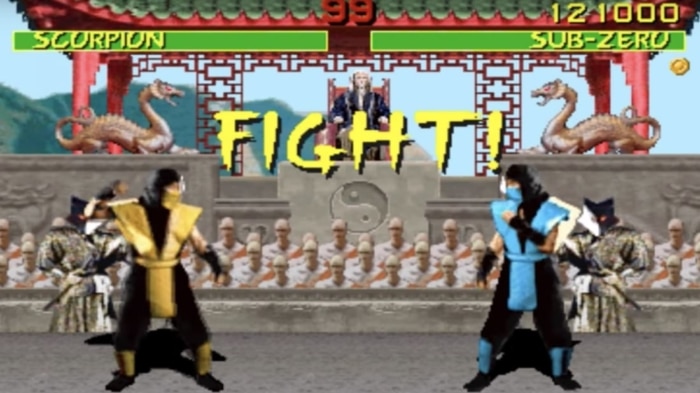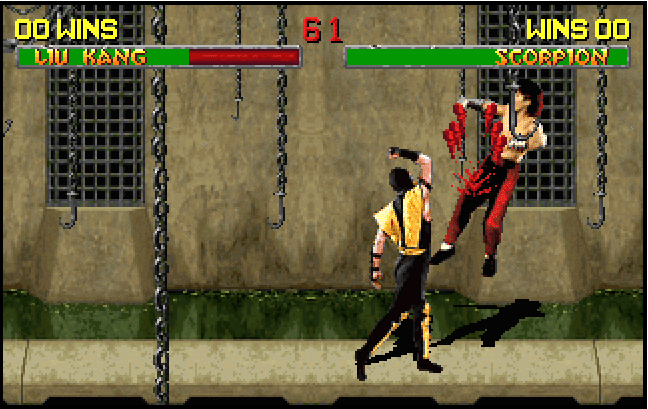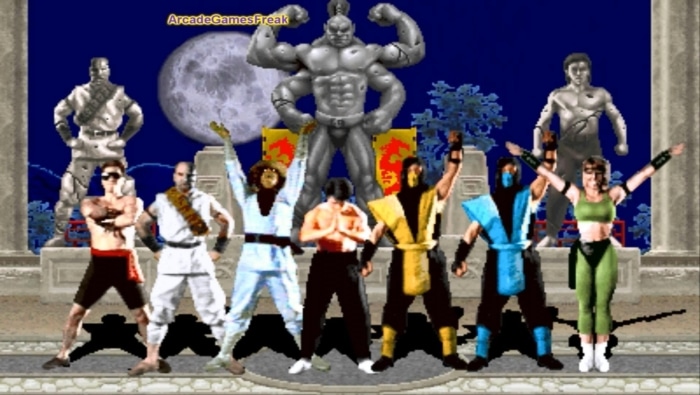Story of a Game: Mortal Kombat
Games have stories. Not just stories of how they were developed, but stories from the people that played them and the way they affected the gaming world.
In this series, Ultimate Gaming Paradise is going to bring you some of the stories of games, from headline-making triple-A titles to some indie masterpieces.
Put your precious sensibilities to one side, jump back almost 30 years in the time machine, and take a look at one of the greatest fighting games ever made: Mortal Kombat.
Get over here
It’s 1992. You walk into an arcade and one machine, in particular, catches your attention due to the throng of people around it. Pushing through the crowds and the noise, you take a look at something that looks almost real—are those actual film-quality visuals of the people? Then one person rips the head from another, the spinal cord dangles from their hand, and there’s blood everywhere.
Fatality!
At this point, you have a choice: you can turn away, disgusted, or you can join the millions of people about to become Mortal Kombat fans. Of course, there’s no real choice here—you’re picking the latter.
Games that changed the world
Every studio would love to say they had a game that changed the world. Midway can claim that many times over, as the people that brought Space Invaders and PacMan to the west.
They did it again with Mortal Kombat.
It’s not just the longevity and impact of the series itself, but Mortal Kombat (along with the lesser-known Night Trap) was responsible for the US Congress creating the ESRB game rating system and similar systems showing up around the world. Before 1992—before Mortal Kombat—there was no such regulation.
Amusingly, the reactions to Mortal Kombat at the time feel extreme today, with one senator reacting to what he’s being shown on a screen with the words “child abuse, that’s what it is”.
Umm, no. Gratuitously violent Mortal Kombat, maybe, but everyone involved is clearly over the age of consent. Glad we cleared that up!
It is violent, though, and, for the time, the digitised graphics of real people looked, well… real. It may not hold up today, but in 1992 Mortal Kombat was the cutting edge of realistic computer gaming, and plenty of people were shocked and didn’t think tearing out someone’s heart and holding it while the blood dripped to the ground was OK. Fair enough.
Digitising martial artists
One of the keys to Mortal Kombat’s success was that graphical take. Rather than relying on cartoony-type graphics that their main competitor, Street Fighter II, had polished, the small team behind Mortal Kombat were looking for something else.

Originally, they’d wanted to make a game based on Jean Claude Van Damme. The early 1990s were a boon for martial arts and action films, and JCVD was one of the highest-profile stars of the time. His moves were unique, and his fan base was extensive.
Minor problem though–he said ‘no’.
Whether it’s from a sense of bitterness or simply because work had already gone into the character’s move-set, it doesn’t take too much watching of early 90s Van Damme classics to see the similarities between Johnny Cage and the real-life fighter. Punching to the nuts while doing the splits..? 1988’s Bloodsport was not just inspiration; it was actually used as the source material for the graphics of an early demo.
JCVD choosing not to participate didn’t mean the concept of putting real people into the game was shelved, however. Instead, John Tobias, one of the four men responsible for that first game, pulled in friends he knew from high school that had got into martial arts. They formed the roster of actors for the characters in Mortal Kombat, each of them filmed and photographed doing their thing while the team painstakingly cut away the backgrounds in photoshop. It wasn’t even green-screened, so the task meant a laborious hand-deleting of backgrounds to leave the wanted images.
It’s all about character
Anyone making a fighting game at the time was going to take tips from Street Fighter II, and one of the key things that made that other game such a success was the character choices. Midway’s team knew that and quickly latched on to having a group of playable characters, each with their own look, move-set, and story background.
Players fell in love with them, just as they had with Ryu, Guile and their friends, coming back to the arcade cabinet time and time again to learn more moves and polish techniques.
Even before it got a name, Mortal Kombat was trying to position itself as the bad-boy of fighting games. The violence, the blood, the exaggerated moves… all of this was part of the style from very early on.
It was encapsulated in some of the characters. People like Sub Zero, with his masked face and magical ice skills, and Raiden, throwing lightning bolts across the screen, were great to draw in fans, but it was Scorpion who topped every list of favourite characters.
The visceral feel of his kunai as it pierces flesh and then drags the victim over for a perfect uppercut; the deep, remorseless command of his signature line: “get over here”; the powerful teleport move to confuse his victims; and that engulfing fatality, where he tears off his own face to reveal the skull beneath before immolating his staggering opponent in flames—all of it combined to make a masterpiece of character creation that still stars in the franchise today.
Even those who didn’t love Scorpion, however, found their favourite. MK1 was thin on female characters, with only the so-so Sonya Blade to pick, but it’s a minor failing in an otherwise brilliant line-up. It even included the other big martial arts megastar, Bruce Lee, in the form of Liu Kang—what more could they do?
Hitting the home market
A year after its arcade dominance, Mortal Kombat came into your home.
At this point, it is worth saying the there was a port of MK1 for pretty much everything viable at the time, but there is no doubt that there was only one version that counted—the Sega Megadrive one (that’s Genesis if you’re in the US).
Mortal Kombat was so tied to the Megadrive that it became a simple fact that if you played MK, you were a Sega owner, and if you had a SNES, you played Street Fighter II. It further reinforced the stereotypes that surrounded the two battling consoles: Megadrive was for older teens, bad-boys themselves, and SNES was for children, who like bright graphics and Mario.
People bought Megadrives to get their hands on Mortal Kombat. They held Mortal Kombat parties where their friends would play through the night, keeping awake with piles of Coke cans and whatever represented the Red Bull and Monster drinks of the time (Red Bull itself didn’t actually hit UK shores until 1994, Monster in 2002, though there were things like Mountain Dew and Jolt Cola. But I digress…). It was a laughter-filled, sweaty, headache-inducing time of fierce competition and hope. Hope that the next randomly hammered sequence of buttons would yield the secrets of the coveted fatality moves. This was a time before the internet; you had to learn these things through trial, error and the whispers of rumour, not just watch a YouTube tutorial.

And MK on the SNES? Nintendo sensibility and censorship took hold there, cutting the blood from the game where the Megadrive version didn’t (though you had to know the unlock code), stripping it of fatalities, and neutering the masterpiece until it barely resembled itself. It may say ‘Mortal Kombat’ on the box and sport superior graphics, but it wasn’t really Mortal Kombat in the box.
Story and setting
Mortal Kombat quickly grew a considerable fan following, and while some of that may have been because it’s a good fighting game and more because it felt more adult than its competitors, a great deal was due to the storyline.
Which is utterly ridiculous.
For those that don’t know, the basic premise of Mortal Kombat is that there are some bad guys out there in a different dimension (world, plane, whatever) who are going to take over the Earth and force us into submission unless a hero representing our home wins in the Mortal Kombat tournament.
Yup, it’s total drivel.
But it is compelling drivel. Enter the world of Mortal Kombat, and you will soon find yourself choosing Liu Kang not just because he’s Bruce Lee with fireballs but because he’s the representative we need. He’s the hero that’s going to save the world. Let’s face it, it’s not going to be Johnny Cage.
You begin to appreciate the backgrounds; is that Earthrealm? Are we entering a temple? Where is this bridge, and how long have those corpses lain rotting on the spikes of the pit?
You start to understand the pain of Goro, Shang Tsung’s champion, whom you have to face in the penultimate round.
And you have true hatred and a need for vengeance against Shang Tsung himself as you fight his shapeshifting sneakiness in those final moments before you can drop the controller and punch the air in triumph. You have defeated the evil warlock! You are victorious! The Earth is safe for a little while longer!
Building the Mortal Kombat franchise
It’s no surprise that the impressive success of the first Mortal Kombat game led to a sequel, then a third and… at the time of writing, Mortal Kombat 11 is the latest iteration in a game series that still has a good few years of life left in it—30 years so far, why not 30 more?
Mortal Kombat II saw more characters, especially stretching the female options with Kitana (everyone’s favourite scantily-dressed fan-wielding princess) and Mileena rounding out the options. It also saw a number of gameplay improvements and holds up much better through the years than its predecessor. With the knowledge that Mortal Kombat had made so much revenue for arcades the first time around, MK2 machines were easy to find, with many places with the space willing to see how an arcade machine of this calibre could add to their profits. Personally, I enjoyed a Mortal Kombat II cabinet in the burger bar a mere few minutes from my home, meaning I ate too many burgers as well as pouring far too many pound coins into the spectacular fighting game.
Games aside, it was with the first Mortal Kombat film that the franchise really showed itself to have what was needed. Unlike the earlier Street Fighter film that both took itself far too seriously somehow and had JCVD in it, the Mortal Kombat film was tongue-in-cheek, fantastic with its special effects, and perfect with its script. An overlooked masterpiece, no doubt!
A team of four
Mortal Kombat’s team was incredibly small, made up of only four men: Ed Boon, principle programmer (and also the voice-over guy for the first game in the series); John Tobias, art and animation; John Vogel, the graphics man; and Dan Forden, responsible for the music. A project of passion, the game was completed in just ten months, with a lot of late-night programming sessions (and no doubt some of that Jolt Cola and Mountain Dew that the players needed later on). They were making a game to rival the biggest fighting game of all time, and with a completely unique take on how irreverence can lead to success, they did it.
Who’d have thought that all you needed to take down Ryu and his friends was a cheesy punch to the balls?

Finish him!
Mortal Kombat was groundbreaking. The use of digitised graphics, the blood and violence, the humour when Dan Forden pops up from the side and says a high-pitched ‘Toasty!’, the inclusion of an additional hidden character in Reptile, a bonkers storyline that can compete with any JRPG, impressive special moves—all of it pales in comparison with the sheer impact of the fatality move.
With crazy button sequences and precise positioning required, the moves were just about possible to hit randomly but otherwise took a lot of practice to master. But they encapsulated everything MK was about—at the end of the fight, you kill your opponent as viciously as possible. This is, after all, Mortal Kombat.
Looking back at them now, though, what was all the censorship fuss about?

